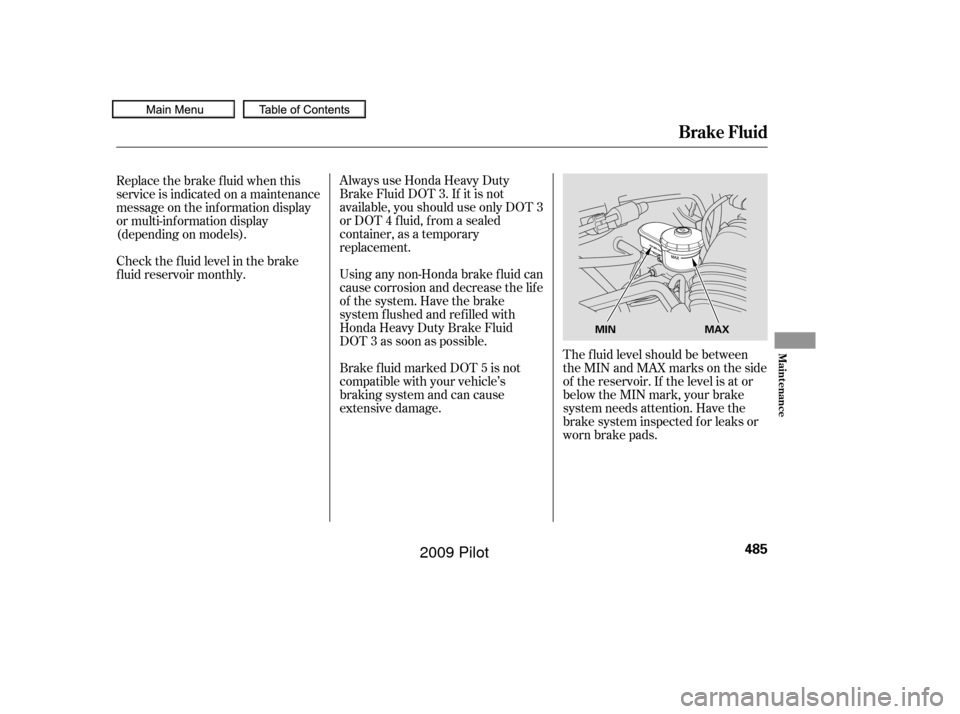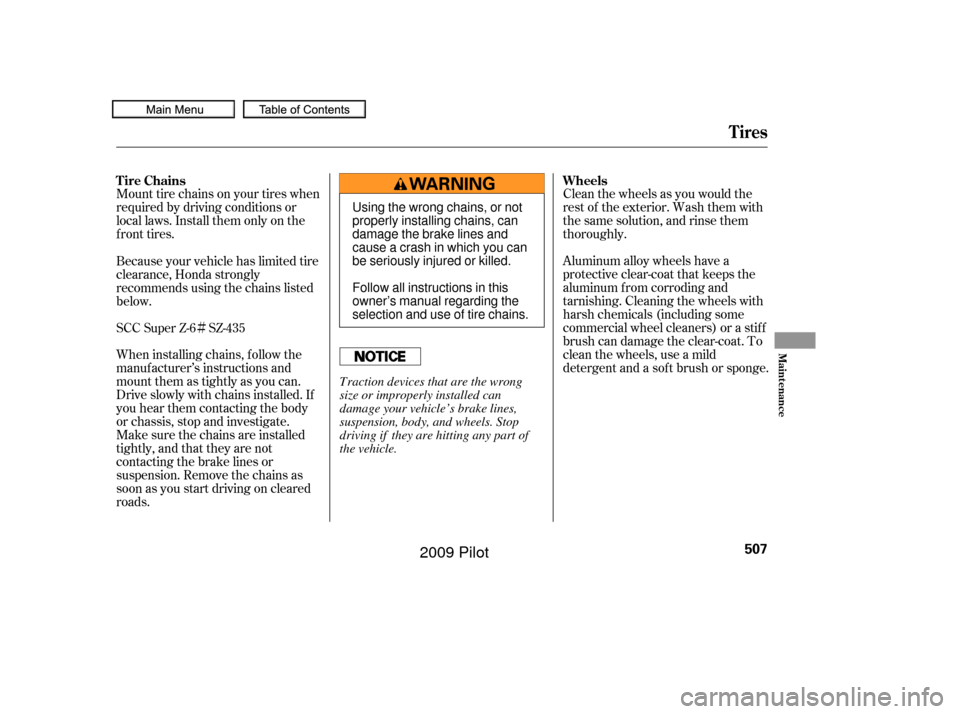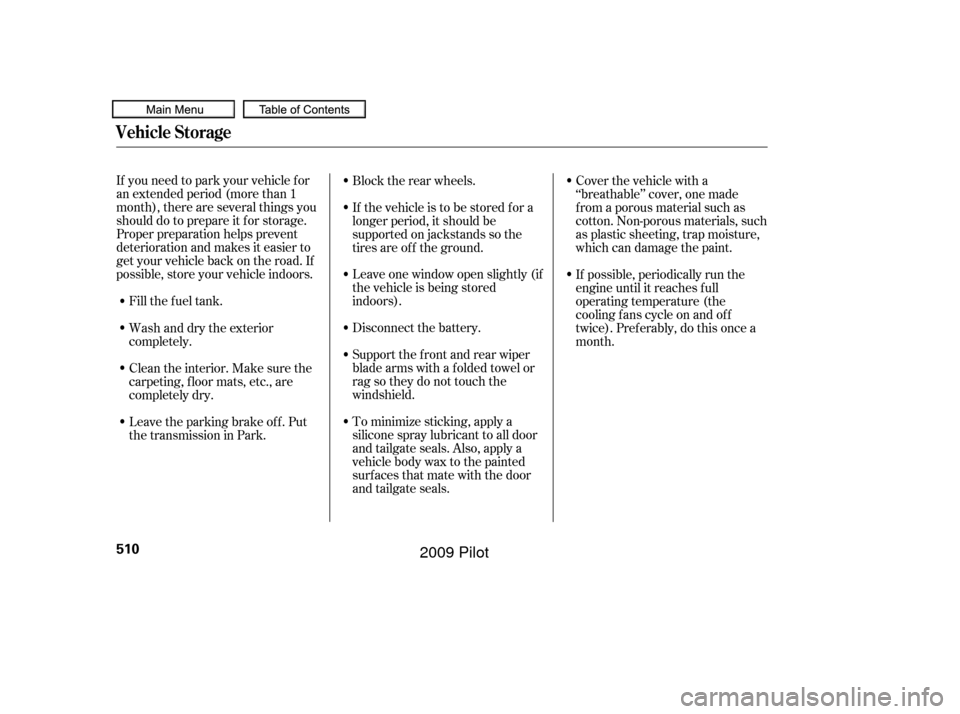Page 476 of 578
�µ�µ
�µ
Lights Check the operation of
the headlights, parking lights,
taillights, high-mount brake light,
and license plate lights monthly.
See page . Brakes Check the f luid level
monthly. See page .
Tires Check the tire pressure
monthly. Examine the tread f or
wear and foreign objects. See page .
501 485
487
Maintenance Minder
472
�����—�����—�
���y�
������
��
���y���
�(�/���������y���������y
2009 Pilot
Page 477 of 578

�Ì�Ì
�µ�µ
�Ì
Maintenance Minder
473
Maintenance Main Items
Replace engine oil
Replace engine oil and oil filter
Inspect front and rear brakes
Check parking brake adjustment
Inspect these items: Tie rod ends, steering gear box, and boots
Suspension components
Driveshaft boots
Brake hoses and lines (including ABS)
All fluid levels and condition of fluids
Exhaust system
Fuel lines and connections Maintenance Sub Items
Rotate tires
Replace air cleaner element
Replace dust and pollen filter
Inspect drive belt
Replace transmission and transfer fluid
Replace spark plugs
Replace timing belt and inspect water pump
Inspect valve clearance
Replace engine coolant
Replace VTM-4 rear differential fluid
Symbol
Symbol
A B 1
2
3
4
5
61
1
If the message, ‘‘SERVICE’’ does not appear more than 12 months after
the display is reset, change the engine oil every year.
See information on maintenance and emissions warranty on page .
Independent of the maintenance messages in the information display,
replace the brake fluid every 3 years.
Inspect idle speed every 160,000 miles (256,000 km).
Adjust the valves during services A, B, 1, 2, or 3 if they are noisy. 471
If you drive in dusty conditions, replace every 15,000
miles (24,000 km).
If you drive primarily in urban areas that have high
concentrations of soot in the air from industry and from
diesel-powered vehicles, replace every 15,000 miles
(24,000 km).
If you drive regularly in very high temperatures
(over 110°F, 43°C), in very low temperatures
(under 20°F, 29°C), or towing a trailer, replace every
60,000 miles (U.S.)/100,000 km (Canada).
Driving in mountainous areas at very low vehicle
speeds or trailer towing results in higher level of
mechanical (shear) stress to fluid. This requires
differential fluid changes more frequently than
recommended by the Maintenance Minder. If you
regularly drive your vehicle under these conditions,
have the differential fluid changed at 7,500 miles
(12,000 km), then every 15,000 miles (24,000 km).
:
1:
NOTE :Maintenance Schedule for Normal Conditions
�����—�����—�
���y�
������
������y���
�(�/���������y���������y
2009 Pilot
Page 478 of 578
Fluid Locations
474
WASHER FLUID
(Blue cap)RADIATOR CAP
ENGINE OIL DIPSTICK
(Orange loop)
AUTOMATIC
TRANSMISSION
FLUID DIPSTICK
(Yellow loop)
POWER STEERING FLUID
(Red cap)
ENGINE COOLANT
RESERVOIR
ENGINE OIL FILL CAPBRAKE FLUID
(Black cap)
�����—�����—�����y�
���������
���y���
�(�/���������y���������y
2009 Pilot
Page 489 of 578

Always use Honda Heavy Duty
Brake Fluid DOT 3. If it is not
available, you should use only DOT 3
or DOT 4 f luid, f rom a sealed
container, as a temporary
replacement.
Using any non-Honda brake f luid can
cause corrosion and decrease the lif e
of the system. Have the brake
system f lushed and ref illed with
Honda Heavy Duty Brake Fluid
DOT 3 as soon as possible.
Brake f luid marked DOT 5 is not
compatible with your vehicle’s
braking system and can cause
extensive damage.The f luid level should be between
theMINandMAXmarksontheside
of the reservoir. If the level is at or
below the MIN mark, your brake
system needs attention. Have the
brake system inspected f or leaks or
worn brake pads.
Replace the brake f luid when this
service is indicated on a maintenance
message on the inf ormation display
or multi-inf ormation display
(depending on models).
Check the f luid level in the brake
f luid reservoir monthly.
Brake Fluid
Maint enance
485
MAX
MIN
�����—�����—�
���y�
�������������y���
�(�/���������y���������y
2009 Pilot
Page 496 of 578
Place a cloth on the edge of the
lens segment. Remove each lens
segment by caref ully prying on its
edge with a small f lat-tipped
screwdriver.
Remove the screw under each lens.
Pull the high-mount brake light
assembly out of the vehicle.Remove the lens f rom the light
assembly.
Pull the bulb straight out of its
socket. Push the new bulb straight
into the socket until it bottoms.Turn on the lights to make sure
the new bulb is working. Put the lens back on the light
assembly, and tighten the
mounting bolts securely.
Put the light assembly back into
the vehicle. Install the screws and
tighten them securely.
Reinstall the lens segments.
Remove the two mounting screws
f rom the light assembly.
1.
2.
3. 4.
5.7.
8.
9.
6.
Lights
Replacing a High-mount Brake
Light Bulb
492
LENS SEGMENT
�����—�
���—�
���y�
����
��������y���
�(�/���������y���������y
2009 Pilot
Page 511 of 578

�Ì
Mount tire chains on your tires when
required by driving conditions or
local laws. Install them only on the
f ront tires.
Clean the wheels as you would the
rest of the exterior. Wash them with
thesamesolution,andrinsethem
thoroughly.
Aluminum alloy wheels have a
protective clear-coat that keeps the
aluminum f rom corroding and
tarnishing. Cleaning the wheels with
harsh chemicals (including some
commercial wheel cleaners) or a stif f
brush can damage the clear-coat. To
clean the wheels, use a mild
detergent and a sof t brush or sponge.
When installing chains, f ollow the
manuf acturer’s instructions and
mount them as tightly as you can.
Drive slowly with chains installed. If
you hear them contacting the body
or chassis, stop and investigate.
Make sure the chains are installed
tightly, and that they are not
contacting the brake lines or
suspension. Remove the chains as
soonasyoustartdrivingoncleared
roads. Because your vehicle has limited tire
clearance, Honda strongly
recommends using the chains listed
below.
SCC Super Z-6 SZ-435 T ire Chains
Wheels
Tires
Maint enance
507
Using the wrong chains, or not
properly installing chains, can
damage the brake lines and
cause a crash in which you can
be seriously injured or killed.
Follow all instructions in this
owner’s manual regarding the
selection and use of tire chains.
Traction devices that are the wrong
size or improperly installed can
damage your vehicle’s brake lines,
suspension, body, and wheels. Stop
driving if they are hitting any part of
the vehicle.
�����—�����—�����y�
�������������y���
�(�/���������y�����
���y
2009 Pilot
Page 514 of 578

If you need to park your vehicle f or
an extended period (more than 1
month), there are several things you
should do to prepare it f or storage.
Proper preparation helps prevent
deterioration and makes it easier to
get your vehicle back on the road. If
possible, store your vehicle indoors.Fill the f uel tank. Block the rear wheels.
If the vehicle is to be stored f or a
longer period, it should be
supported on jackstands so the
tires are of f the ground.
Leave one window open slightly (if
the vehicle is being stored
indoors).
Disconnect the battery.
Support the f ront and rear wiper
blade arms with a f olded towel or
ragsotheydonottouchthe
windshield.
To minimize sticking, apply a
silicone spray lubricant to all door
and tailgate seals. Also, apply a
vehiclebodywaxtothepainted
surfaces that mate with the door
and tailgate seals.Cover the vehicle with a
‘‘breathable’’ cover, one made
f rom a porous material such as
cotton. Non-porous materials, such
as plastic sheeting, trap moisture,
which can damage the paint.
If possible, periodically run the
engine until it reaches f ull
operating temperature (the
cooling f ans cycle on and of f
twice). Pref erably, do this once a
month.
Wash and dry the exterior
completely.
Cleantheinterior.Makesurethe
carpeting, floor mats, etc., are
completely dry.
Leave the parking brake off. Put
the transmission in Park.
Vehicle Storage
510
�����—�����—�
���y�
�������������y���
�(�/���������y�����
���y
2009 Pilot
Page 515 of 578

This section covers the more
common problems that motorists
experience with their vehicles. It
gives you inf ormation about how to
safely evaluate the problem and what
to do to correct it. If the problem has
stranded you on the side of the road,
you may be able to get going again.
If not, you will also f ind instructions
on getting your vehicle towed.......................
Compact Spare Tire .512
....................
Changing a Flat Tire .513
.............
If the Engine Won’t Start . 520
................................
Jump Starting .521
..............
If the Engine Overheats . 523
.........
Low Oil Pressure Indicator . 525
..........
Charging System Indicator . 525
.......
Malf unction Indicator Lamp . 526
...............
Brake System Indicator . 527
..............................................
Fuses .528
..............................
Fuse Locations .532
......................
Emergency Towing .535
..........
If Your Vehicle Gets Stuck . 536
Taking Care of the Unexpected
T aking Care of t he Unexpect ed
511
�����—�����—�
���y�
�������������y���
�(�/���������y�����
���y
2009 Pilot